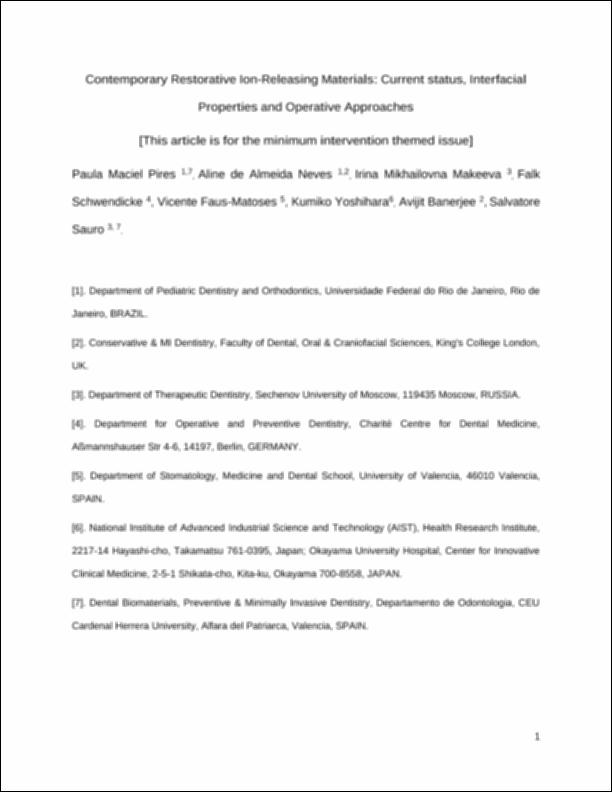Por favor, use este identificador para citar o enlazar este ítem:
http://hdl.handle.net/10637/13202Contemporary restorative ion-releasing materials : current status, interfacial properties and operative approaches
| Título : | Contemporary restorative ion-releasing materials : current status, interfacial properties and operative approaches |
| Autor : | Pires, Paula Maciel Neves, Aline de Almeida Makeeva, Irina Schwendicke, Falk Faus Matoses, Vicente Yoshihara, Kumiko Banerjee, Avijit Sauro, Salvatore. |
| Materias: | Odontología restauradora.; Dentistry, Operative.; Gomas y resinas - Aplicaciones en Odontología.; Caries dental - Tratamiento.; Materiales dentales.; Dental caries - Treatment.; Dental materials.; Gums and resins in Dentistry. |
| Editorial : | Springer Nature. |
| Citación : | Pires, P., Neves, A., Makeeva, I., Schwendicke, F., Faus-Matoses, V., Yoshihara, K. et al. (2020). Contemporary restorative ion-releasing materials: current status, interfacial properties and operative approaches. British Dental Journal, vol. 229, n. 7 (09 oct.), pp. 450-458. DOI: https://doi.org/10.1038/s41415-020-2169-3 |
| Resumen : | Minimally invasive (MI) concepts in restorative dentistry in the year 2020 request from the practitioner, not only a scientifically supported rational for carious tissue removal/excavation and defect-oriented, biological cavity preparation, but also a deep understanding of how to ensure a biomechanically stable and durable restoration in different clinical situations by applying different restorative options. Bio-reactive materials play an increasingly relevant role, as they not only replace diseased or lost tissue but also optimise tissue mineral recovery (among other properties) when used in restorative and preventive dentistry. Indeed, this is of certain interest in MI restorative dentistry, especially in those cases where gap formation jeopardises the integrity of the margins along resin composite restorations, causing penetration of bacteria and eventually promoting the formation of secondary caries. Recently, the interest on whether ion-releasing materials may reduce such biofilm penetration into margin gaps and reduce such a risk for development and propagation of secondary caries is growing significantly among clinicians and scientists. The aim of this article was to explore mechanisms involved in the process that allow mineral deposition at the interface between such materials and dentine and describe how conventional “bioactive” restorative materials currently available on the market may beneficial treatments in MI Dentistry. |
| Descripción : | Este artículo se encuentra disponible en la siguiente URL: https://www.nature.com/articles/s41415-020-2169-3 This is the pre-peer reviewed version of the following article: Pires, PM., Neves, AA., Makeeva, IM., Schwendicke, F., Faus-Matoses, V., Yoshihara, K., Banerjee, A. & Sauro, S. Contemporary restorative ion-releasing materials: current status, interfacial properties and operative approaches. British Dental Journal, vol. 229, i. 7 (09 oct. 2020), pp. 450-458, which has been published in final form at https://doi.org/10.1038/s41415-020-2169-3 Este es el pre-print del siguiente artículo: Pires, PM., Neves, AA., Makeeva, IM., Schwendicke, F., Faus-Matoses, V., Yoshihara, K., Banerjee, A. & Sauro, S. Contemporary restorative ion-releasing materials: current status, interfacial properties and operative approaches. British Dental Journal, vol. 229, i. 7 (09 oct. 2020), pp. 450-458, que se ha publicado de forma definitiva en https://doi.org/10.1038/s41415-020-2169-3 |
| URI : | http://hdl.handle.net/10637/13202 |
| Derechos: | http://creativecommons.org/licenses/by-nc-nd/4.0/deed.es |
| ISSN : | 0007-0610 1476-5373 |
| Fecha de publicación : | 9-oct-2020 |
| Centro : | Universidad Cardenal Herrera-CEU |
| Aparece en las colecciones: | Dpto. Odontología |
Los ítems de DSpace están protegidos por copyright, con todos los derechos reservados, a menos que se indique lo contrario.


